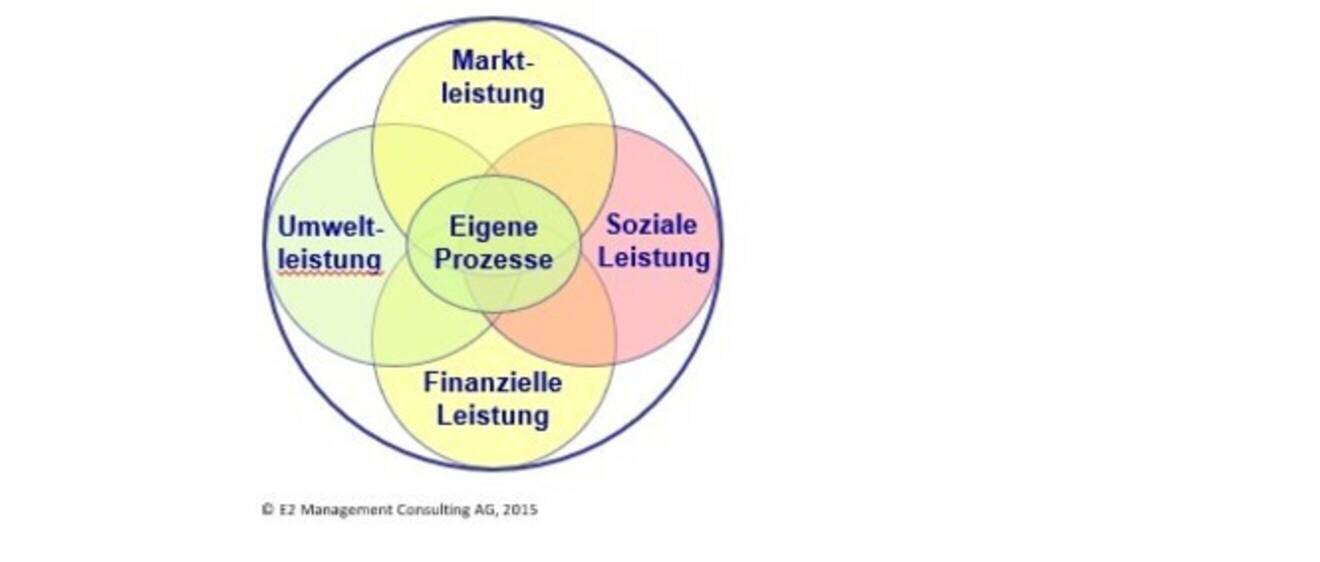Sustainability within Strategic Management More than financial sustainablility
Sustainable corporate management adopts financial, environmental and social performance in order to ensure the company's future and realise competitive advantage.
Four dimensions the sustainability
From a business point-of-view, the concept of sustainability can be depicted by means of the four dimensions: market, financial, social and environmental (see figure). A sustainable corporate strategy actively and complimentarily applies these four dimensions of corporate performance, and integrates them in its processes.

Systematic consideration of all sustainability dimensions
The systematic consideration of all sustainability dimensions within the strategy process and its integration into the processes allows additional benefits to be realised, e.g.:
- Reduce Risk
- Increase Efficiency
- Image care
- Differentiation on the markets
- Spur Innovation
During the initial assessment of strengths, weaknesses, opportunities and threats (SWOT), and in the following development and assessment of strategic options, the traditional perspective is supplemented by the sustainability dimensions. The strategy development and implementation process ensures that ideas are followed by actions.
The broader view - including environmental and social aspects - frequently enables surprising insights and helps in achieving interesting new strategic positions.
Both the growing expectations towards climate neutrality as well as the upcoming regulations on corporate responsibility will effect strategic positioning. In both areas, companies will be challenged on their own activities as well as on their supply chains.
E2 Management Consulting AG Implementation of the Strategy
The sustainability aspects are then cascaded down within the management system. For example, central environmental and/or social aspects are embedded (next to market and financial aspects) within objectives and incentives.
Furthermore, strategy controlling supports the achievement of sustainability targets, be it e.g. with a Sustainability Balanced Scorecard, with indicators from a TQM, with traditional sectorial KPIs, profit center targets or other approaches - and always covering all key sustainability areas.
E2 Management Consulting AG Inside-out versus outside-in: To think sustainability from the outside as well
An interesting link between classic strategy development and sustainability management can be found with T. Dyllick (2015 in german, english and extended in Dyllick/Muff 2016) and their image of "inside-out versus outside-in": they argue that up to now most companies have developed their sustainability goals from within by asking "What do we contribute? - what they call the "inside-out" view. Overall, however, this has (obviously) made too little impact in view of the global sustainability problems, so that companies alltogether continue to be "part of the problem and only insufficiently part of the solution". In this context, they say, the question needs to be asked anew as to what the solution of the sustainability problems requires of each company: The sustainability goals of a company must be developed starting with the objective and asking "what does the company need to contribute" - which they call asking "outside-in".
In strategy development, both perspectives traditionally have an equally important role: Analysing the general situation and identifying opportunities and threats represents an outside-in view, while are strengths and weaknesses of the organisation are analysed with an inside-out view. For sustainability goals, however, these two directions have often not been applied consistently enough, and the call of Dyllick/Muff is useful.
In practice, however, we have to deal with the situation that to date clear general objectives exist in only a few sustainability areas: The Paris Convention provides a valid framework for greenhouse gases, and government legislation can serve as a benchmark for emissions to water and air. The same applies to slave and child labour.
On the other hand we find only rudimentary goals for, e.g., biodiversity, or for education and training, which cannot yet simply be 'rolled out' globally. In such areas, we can find compasses (indicating the direction to go), but not yet yardsticks (indicating how far we have to go - and how to measure developments) for a corporate strategy.
It is therefore valuable to ask the expectations of important interest groups (stakeholders) on sustainability issues during the strategy development in order to continue to form a careful, demanding, but ultimately 'own' stance.
E2 Management Consulting AG Projects

McDonald's (Schweiz)
Environmental and sustainability management, company ecobalance and greenhouse gas assessment, sustainability reporting.
